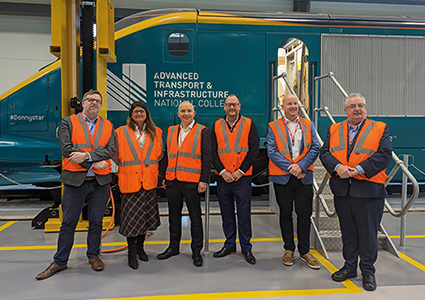
Why we need to address the rail sector’s skills shortage. By Nick Andrew
As an industry, it feels like the skills shortage is something we’ve been talking about for a while. ‘Talking’ being the key word. While that’s fantastic because it means that we’re all working together to raise awareness of the issue, and there’s universal agreement that it’s a problem, time is of the essence if we’re going to ‘fill the gaps’ that are coming.
In 2019, a report by City & Guilds and National Skills Academy for Rail (NSAR) predicted up to 120,000 additional people within the rail industry would be required by 2030, with a demand for skills peaking around 2025.
One of the problems with statistics that concern the future – not just in rail but wherever you find them – is the temptation to think, “ah, 2030, that’s ages away.” Especially when more pressing issues like rising living costs and energy crises loom over us. But 2030 isn’t as far away as we’d like to think. It has been four years since the City & Guilds and NSAR report was published – are we any further to solving the skills conundrum?
The government has announced ‘record investment plans for the transport network’, including rail. The question is, will the rail industry have the workforce to deliver on these plans? I’m confident it will, as long as there is a turnaround to the skills shortfall.
 Luckily, seven years is enough time to do something if we act now and encourage younger generations – or those with transferable skills –
Luckily, seven years is enough time to do something if we act now and encourage younger generations – or those with transferable skills –
to enter the sector.
Cards on the table: preparing for future generations
Over the coming years there are big investment plans for the rail sector, including network upgrades, reinvigorating abandoned stations and modernizing rail technology. Yet, with an ageing workforce nearing retirement and a younger generation perhaps less interested in a career in rail – what can the sector do to encourage young people to jump on board?
This is one of the questions we hope to address in our ‘Talent Track’ campaign, which started by bringing together several leading experts from both academia and the rail industry to debate what the barriers are to rail as a career choice and what needs to be done to overcome the challenges presented by the NSAR report.
The range of participants made for a useful, robust discussion and debate on relevant issues around the relationship between academia and the industry, attracting apprentices and talent into the sector and encouraging greater diversity.
The findings from the discussion are detailed in our report – Keeping Talent on Track: Addressing the skills shortage in the rail sector – where a number of key areas were addressed.
Building an environment that everyone can see themselves in
When it came to diversity, one point that really stood out from one participant was: “I know good undergraduates, very skilled people, who wouldn’t consider rail because it’s not the right environment for them as it doesn’t look like them.”
This is a concerning anecdote, and with the City & Guilds and NSAR research showing lower numbers of women, young adults, and people from BAME backgrounds would consider a rail career, it’s a clear area of focus.
Create clear career paths
We also identified the critical need for a clear path for people to enter the rail industry. It’s one thing to attract the talent, the real test is retaining that talent. For us, it is about working closely with our people and supporting them on their career development.
There is also a need to showcase the sheer variety of careers available in rail. Yes, there are many exciting engineering roles, but looking beyond this there’s legal, finance, marketing, design – a huge variety to attract people to our industry.
Tap into the wider agenda 
To attract the next generation of rail talent, we need to showcase the important role the rail sector plays in the UK. This could include shining a spotlight on its contribution to the green agenda. We are talking to a much more climate-aware generation that wants to work in industries that will have a real impact on reducing emissions.
Rail freight has always provided a low-carbon alternative to road transport. Its strong environmental performance has already helped to reduce UK carbon emissions by up to 7.7 million tons every year. With the introduction and rapid development of greener technologies, from extended electrification projects and battery storage to fuel cells and hydrogen powered trains, this number will keep increasing.
Engage the wider workforce
It is crucial that senior leadership actively encourages the full workforce to champion the rail sector and create positive workplace cultures.
As a former apprentice myself, nurturing the next generation of talent is something that I personally feel strongly about and our apprenticeship scheme is one of my proudest achievements.
That is why we want to make every effort to persuade the next generation, mid-career switchers and anyone with transferable skills, that a career in the rail sector will provide them with the pride and career fulfilment they seek – only then will we be able to address the looming skills crisis.
Planning for the future
The rail industry faces a major challenge when it comes to bridging the skills gap to enable it to deliver the infrastructure that is needed. Companies across the supply chain all have a part to play in promoting the sector as exciting and dynamic. And, crucially, one that promises huge variety and the opportunity to develop pioneering technologies and processes that can make a real difference.
For a list of the sources used in this article, please contact the editor.
Nick Andrew is Managing Director at CWE Ltd. Nick has 30 plus years’ engineering experience including in rail, having started his career as an apprentice. CWE Ltd has been providing specialist, high-quality engineering solutions since 1966. It provides expert component repair, refurbishment and replacement quickly and on budget.